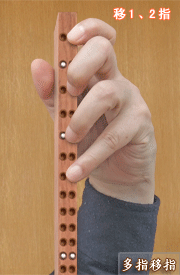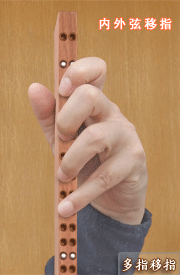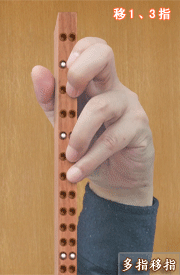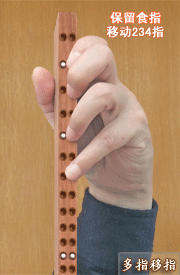Illustration teaching of erhu playing multi-finger movement exercises
The front is the exercise of single-finger movement, and the following can be practiced with multi-finger movement, and the difficulty of the exercise has increased. In fact, this kind of exercise is a finger shape transformation exercise.

Move 1 or 2 fingers

The picture above is to keep the ring and little fingers, and move the index and middle fingers. Such exercises can test the independence and sensitivity of the 123 fingers of the left hand.
In practical applications, such as establishing the correct "222" and "212" finger patterns, such as the correct conversion between the key of D and the key of F in performance, is a typical application.
Move 3 or 4 fingers

The picture above is to keep the index and middle fingers, and move the ring and little fingers.
The above picture is also an exercise of the "222" and "212" finger shape transformation. It can be seen from the figure that during the movement of the 3rd and 4th fingers, the tiger's mouth also moves.
If you want to increase the difficulty of the exercise, you can practice with the tiger's mouth relatively stable.
Inner and outer chord finger shift

The picture above is the practice of moving the fingers of the inner and outer strings.
Note: This exercise should be performed on the same string, or directly on the real piano. This kind of conversion of the inner and outer strings is suitable for the conversion of the finger shape from the key of F to the key of D. Practice the same way as above.
Below is a two-finger movement exercise with increased difficulty. For those with small hands, it is very difficult to stabilize the practice under the tiger's mouth.
Movement exercises for fingers (1, 3 fingers)

The above picture is the practice of 1 and 3 finger shifting. When practicing, keep 2 and 4 fingers to improve the effect of the exercise.
Movement exercises for fingers (2, 4 fingers)

The above picture is the exercise of 2 and 4 finger shifting. When practicing, keep 1 and 3 fingers, but also to improve the effect of the practice.
Proximity Finger Spreading Exercises

The picture above shows the practice of separating and approaching fingers 2 and 3 (retain fingers 1 and 4).
The following are exercises for multiple finger movements (three and four fingers moving simultaneously):
Move 1, 2, 3 fingers

The picture above shows moving the index finger, middle finger and ring finger at the same time. Keep your pinky finger when you practice.
Move 2, 3, 4 fingers

The picture above shows the movement of the middle finger, ring finger and little finger at the same time. Keep your index finger on while you practice.
Move four fingers simultaneously

The picture above is to move four fingers of the left hand at the same time.
 渝公网安备 50010702504639号
渝公网安备 50010702504639号